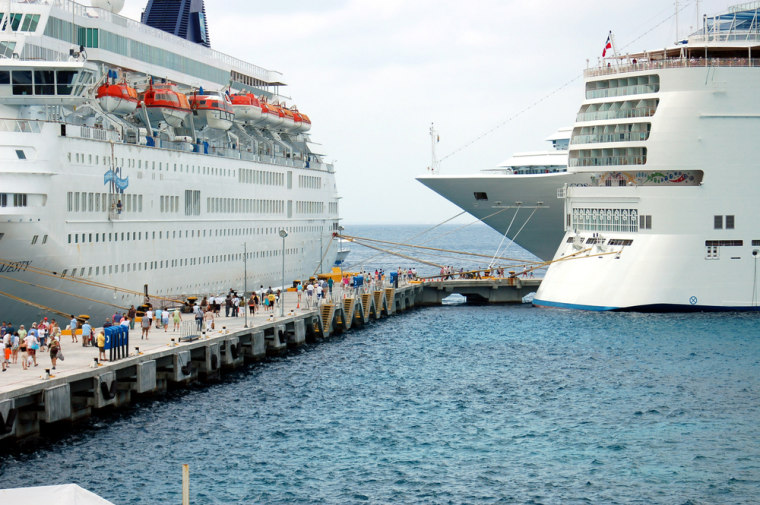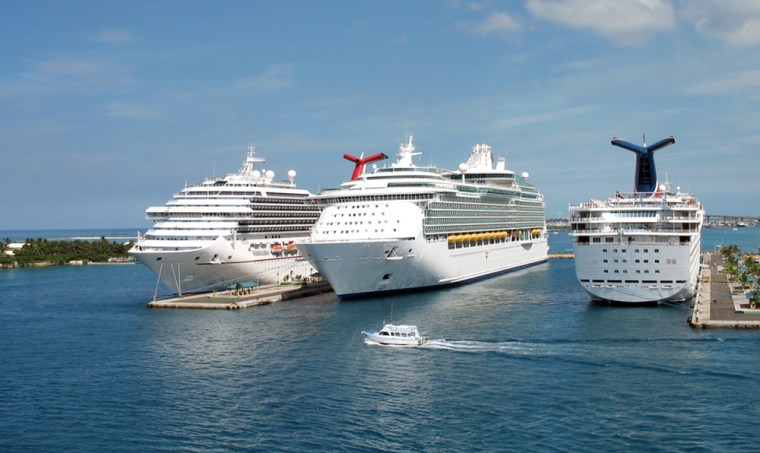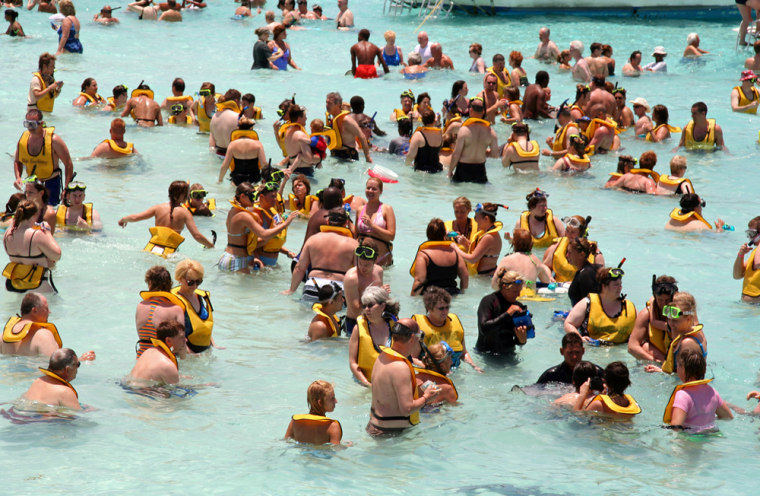The couple kayaking with no one else in sight, lovers watching the sun set from a secluded corner of deck, the family frolicking on a private beach.
Dream on.
Cruise line ads work hard at trying to convey exclusivity, intimacy and seclusion. In the real world, the more than ten million people who cruise every year go to a lot of the same places. Tour buses line up at the docks like advancing armies, while sign-waving guides and freelance touts vie for passengers’ attention.
Take Alaska. Overall, the number of cruise passengers to Alaska has more than tripled since the early '90s, according to the North West CruiseShip Association. is the state’s busiest port and this summer some 650 cruises will call there. Juneau’s local population hovers around 30,000 and on an average day during high season, more than 5,000 cruise passengers fan out around the small town, piling on buses for trips to Mendenhall glacier and other local attractions.
In , an island just 13 miles long and four miles wide, almost two million tourists arrived by cruise ship in 2006, according to research consultant G.P. Wild International Ltd. Six to eight giant ships a day is business as usual at this Caribbean evergreen — we’re talking more than 20,000 cruisers on an average day heading for the same few beaches and attractions. It’s the same deal in and , where traffic jams are as prevalent as sunburns and hangovers.
The smallest ships carrying just 100 or 200 passengers don’t make a dent, it’s the 2,000-passenger and bigger guys that have the most dramatic impact. Behemoths like Royal Caribbean’s new Liberty of the Seas can carry more than 4,000 passengers, and half that in crew. The weekly rotation includes and or St. Maarten and San Juan.
The has been the No. 1 cruise ship destination for years. In both 2005 and 2006, the Caribbean accounted for about 40 percent of the North American-based cruise fleet, according to the Cruise Lines International Association (CLIA), a trade group. The Mediterranean and Europe accounted for about half as much in each of the past two years, followed by a virtual three-way tie by Alaska, the Bahamas and the Mexican Riviera, each just under about 10 percent of the total market. But it’s not just the numbers who show up, it’s the size of the port that matters most.

Some ports can handle the onslaught better than others.
While large cities like Barcelona and Naples have populations in the millions and can easily absorb another 20,000, it’s a different story for small islands and coastal towns. Their physical space is simply limited. In tiny places along the Cote d’Azur for instance, the tourists can easily outnumber the locals. Same goes for the Greek islands.
“It really depends on the port and how well they and we handle the guest experience," says Mark Conroy, president of Regent Seven Seas Cruises. "St. Petersburg, for example, is a big city and deals pretty well with the millions of guests it gets each year. A port like Grand Cayman, Monaco or Juneau, on the other hand, suffers so we try not to be there when all the other ships are.”
According to Adam Goldstein, president of Royal Caribbean, stretching the Europe and Alaska cruise seasons beyond the summer months — from as early as April through as late as November — helps to alleviate crowding for those willing to accept cooler temperatures.
“The lengthening of the non-peak season in Europe is creating more choice for our customers,” says Goldstein, adding that they’ll even be positioning a ship year-round in Europe in 2008.
Another way to get around the crush at certain ports is by breaking out of the traditional Saturday to Saturday cruise paradigm. More and more lines are offering departures for weeklong cruises on Fridays or Sundays too. Conroy says Regent skirts the jam up in Juneau by operating its Alaska cruises on a Wednesday to Wednesday schedule, in order to be there on the days when the fewest number of ships are in town. In the Caribbean, many lines also pack their itineraries with visits to their private islands, where generally only one ship — two max — is there at a time.
At the end of the day, some tourists like the hustle bustle of ultra-popular ports. Those that don’t should cruise during the off-season or on smaller vessels of lines like SeaDream Yacht Club and Star Clipper, which tend to avoid the beaten track as much as possible.

“Regardless of the volume on a given day," says Goldstein, "there will be people who enjoy the port experience because of the particular excursions they have chosen." He adds that "to the extent there is congestion, a percentage of the guests will be negatively affected by it."
Hordes or not, millions still get bit by the cruise bug and happily take to the high seas. "Generally, across the cruise industry, passenger satisfaction is much higher than for any other type of vacation, whether in North America or Europe," says Peter Wild of G. P. Wild International. Read on to find out which ports are the most overcrowded and, perhaps, overrated.
